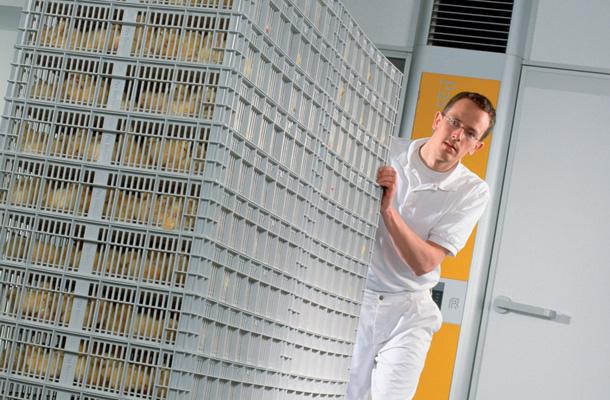Hatcher basket hygiene for a clean start
Tags: Washing and waste handling | Whitepaper
, 2 April 2012

The hygiene status of the environment into which chicks are hatched has a direct impact on day-old-chick quality and first week mortality.
The first environment encountered by the chicks is the hatcher basket and its contents. Hatcher baskets are used intensively, often twice a week. Keeping them scrupulously clean between cycles will pay dividends.
Weak egg shells combined with breakage due to rough handling during transfer can smear the chick’s down – and these chicks are often culled, to avoid customer complaints. Exploding eggs, due to contamination, expose the newly hatched chicks to a high bacterial challenge. In suboptimal incubation conditions, chicks that hatch without a fully closed navel are most vulnerable, as this forms a point of entry for pathogens that will lead ultimately to increased first week mortality by yolk sac infection.
Eggs should be transferred in properly cleaned and disinfected hatcher baskets. Dirt left behind from a previous hatching cycle, such as meconium (the greenish droppings produced by the chicks), pieces of eggshell, fluff, blood and egg contents, should be thoroughly removed prior to disinfection.
Hatcher baskets are best washed directly after the removal of chicks and hatch residue. Washing hatcher baskets manually with a scrubber, or semi-manually with a high pressure cleaner, can give results that equal washing in a purpose-designed automatic washing machine, but it is very labour intensive. In more sophisticated automated washing systems, a stacking and destacking module allows pre-soaking time, for thorough, easier cleaning.
Other measures for optimised cleaning and disinfection are:
- Temperature: washing water should be not higher than 50 – 60 ◦C, to prevent the coagulation of proteins. At minimum, 40 °C will give adequate cleaning results.
- Detergent: use an alkaline-non foaming detergent (with or without hypochlorite) at the recommended concentration, alternating occasionally with an acid detergent, to prevent the build-up of scale.
- Mechanical effect: Maintain the pressure and direction of the washing water; e.g. quality of nozzles and proper adjustment. Higher pressure gives better results.
- Time: The speed with which the hatcher baskets pass through washing; slower transit produces better cleaning results.
- Rinse thoroughly with clean water
- Follow washing with disinfection, using a broad-spectrum disinfectant
A hatcher basket manufactured to include a microbiological agent in the polymer from which it is made provides continuous protection between cleaning cycles.
If the washing process gives good cleaning results, there is no benefit to using paper in the baskets, unless the batch includes many exploders. In this case, the paper will absorb some of the mess and the chicks are more likely to stay clean. The use of paper with high absorbency and enough grip for the chicks to avoid “splay legs” is recommended. Newspaper is not suitable. If paper is used, check that it does not hamper air flow over the eggs and hatched chicks by making sure that it fits inside the base of the basket - and cover entirely with eggs, to keep it down.
Advice
- Clean and disinfect hatcher baskets thoroughly after every use.
- Evaluate cleaning results regularly by visual inspection and take corrective action when needed.
- Monitor the effect of disinfection by taking staking swabs or Rodac-plates.
- Allow baskets to dry thoroughly before the next transfer; consider an extra set of hatcher baskets if this cannot be achieved.
- Consider whether to use paper in the hatcher baskets carefully: incorrect use will have a negative impact on airflow and could affect hatchability and chick quality.
Written by Gerd de Lange
Senior Poultry Specialist
I welcome your feedback on this article - and if you require any additional information, please don't hesitate to contact me.